Tennessee Fly Fishing: Top 7 Places for the Best Trout Fishing
If Tennessee fly fishing is on your bucket list or you’re a Tennessean just looking for the next best creek to fish, this guide is for you! We took some time to highlight our top 7 rivers that have the best fly fishing opportunities in the state. Whether you’re wanting to hop on the tailwaters or hit the streams in our beautiful mountains, this guide is for you! With our regions temperate climate, it makes for the perfect habitat for supporting healthy trout populations year round. This guide will cover the best waters to fish, what kind of trout you can find, and the best flies to use when fishing there. Grab a drink and come see why these trout fisheries made our list!
1. Tennessee Fly Fishing: South Holston River
The South Holston River, or SoHo as locals call it, is one of the best blue ribbon trout streams in the nation. Anglers come from all over the United States to access this famous tailwater. Since it has great water temperatures year round, it’s home to a variety species including brown trout, rainbow trout, smallmouth bass and even stripers making their way up from Boone Lake! It’s also known for its abundant number of wild brown trout.
The South Holston hasn’t been stocked with brown trout since the early 2000’s due to its excellent water quality and environment. This has, of course, created an excellent habitat for the trout population to thrive in. Boasting nearly 8,500 wild trout per mile, this puts it at the top of the list as our #1 for this Tennessee fly fishing list! Book your next fly fishing trip on the South Holston River with us and experience this beautiful fishery!
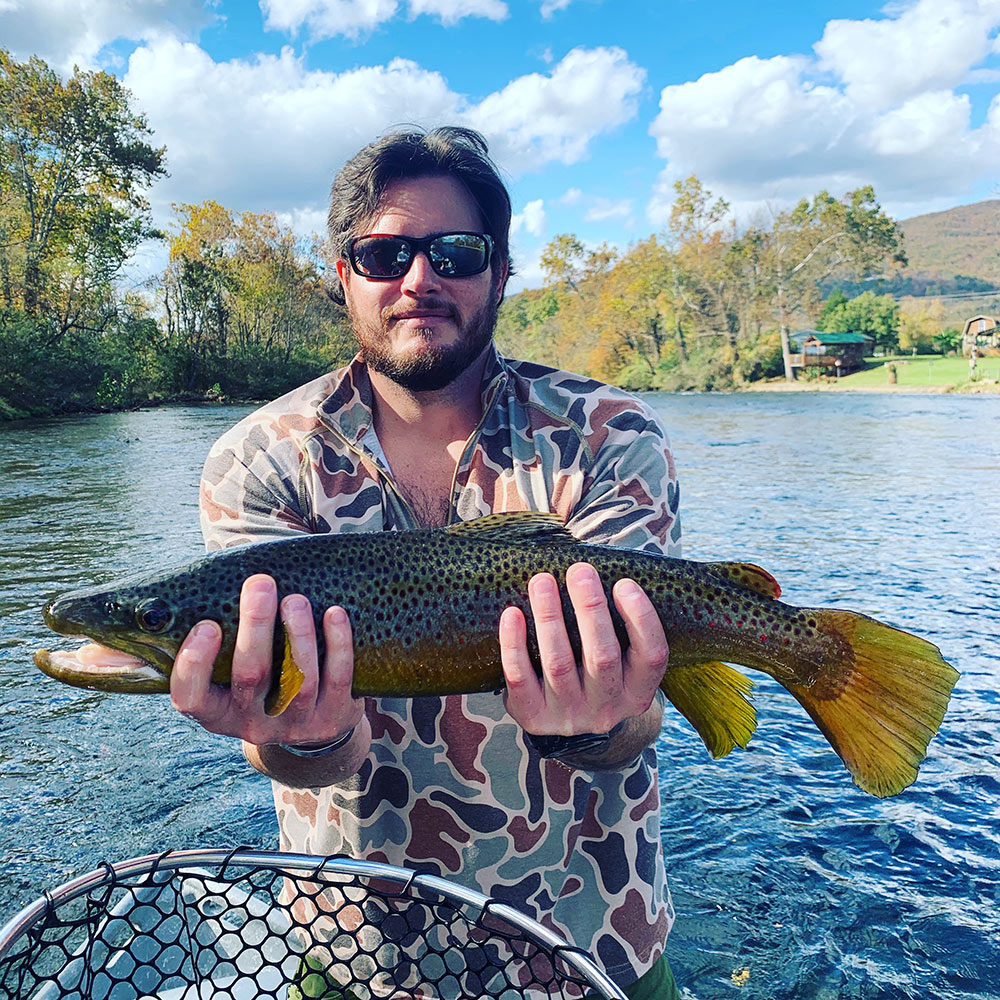
Where to fish
Starting at the South Holston dam and making it’s way to Bluff City, there are numerous access points for the wading angler. With the entirety of this section of river being navigable by boat, it offers plenty of opportunity to chase after those trophy trout that it’s known for. The size of the fish here average around 8-12 inches. It should be noted that there is a spawning section of the river that is off limits to fishing during certain months of the year. You can check out our ultimate guide for South Holston River trout fishing to learn more about that. We also included the best sections to wade and float fish in that guide as well.
Best Flies to Use
Fly selection is always going to be dependent upon the hatch and what trout are feeding on day by day. We have developed a South Holston River Hatch Chart to help give you some direction on what that looks like though.
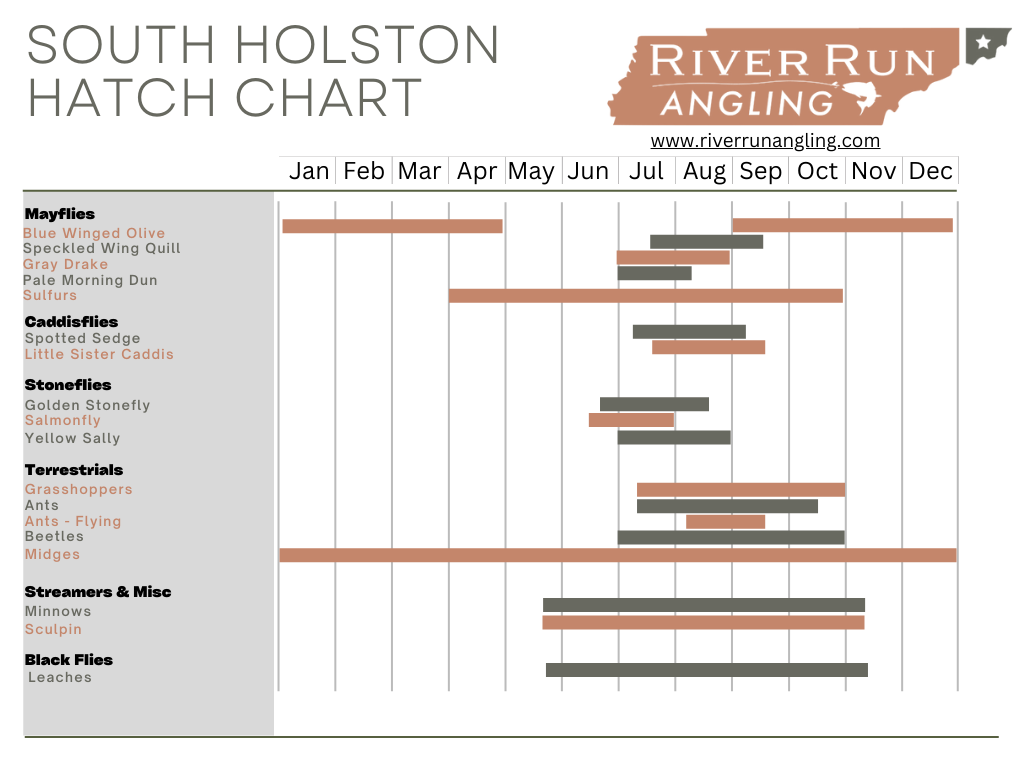
2. Tennessee Fly Fishing:
Little River (GSMNP)
Located in the Great Smoky Mountains National Park (GSMNP) lies this gem of a trout stream. Some would say that there is no better Tennessee fly fishing than right here in the GSMNP. Don’t let the name fool you though, this is anything but a river. It’s more of a large stream. You’ll find browns, rainbows and brook trout here. Some of the sections will have some day use swimmers in the pools and such, but by in large, much of the stream is open for anglers. There are some sections that are difficult to access, especially in the higher elevations, but most of the stream is accessible for wading. With it’s convenience to Knoxville, this stream is a must fish every fly fishing enthusiast. One thing to mention about the park is that either a TN or NC fishing license covers both sides, no matter which side your license is on. Check out their site for more information and an in depth map of the park.
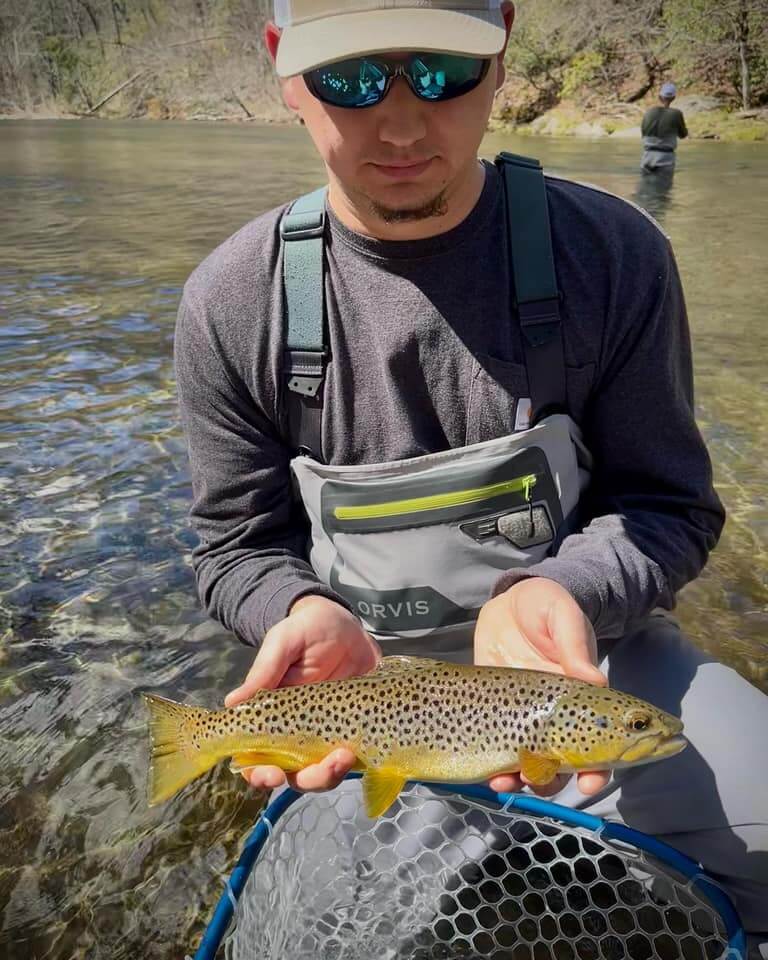
Photo Credit: Hunter Palmer
Where to fish
Lower Section from Townsend to Sinks
You’ll still find some wild rainbows and browns through this section, but they aren’t as prevalent as they are upstream. You may be able to find some bass that have wondered upstream from the lake through here as well. This is also a very popular section for whitewater boaters, so you’re better off fishing upstream toward the more wild sections.
Middle Section From Sinks to Elkmont
As you make your way upstream from the Sinks, you’ll pass several parking spots on the side of the road that you can access the stream from. About 2 miles up the road from the Sinks is Metcalf Bottoms. There is a picnic area here that you can park at and access the stream and the fishing is pretty phenomenal here. During some of the prolific hatches, the pools are stacked with trout and it’s a good day for dry fly fishing. There is about 6 miles of stream from Metcalf until Elkmont. There is an abundance of trout here as well as some big fish that like to hide in the deeper pools.
Backcountry Section above Elkmont
This section is our favorite because it’s far away from the crowds. This area of the Little has far less fishing pressure than the downstream sections, primarily because of the extra effort required to reach it. This is truly the section to chase after wild trout. With the geography being a bit more steep, this also means you won’t find as many big fish here either. As the stream narrows here, that means that technical fishing and casting techniques are needed. There are several backcountry camp sites that parallel the river, but you’ll need to get a permit for them through the park service. Brookies increase in population as the elevation does. If you’re looking for a great camping trip to accompany your fishing, this section is for you!
Best flies to use
This stream, like most others, boasts a diverse insect population. From mayflies to bait fish, you have the whole range of fly selection. Some of the most prolific hatches are Blue Quill, Blue Quill Gordons, BWO and Little Black Caddis. For our dries, we typically fish a dropper underneath to get down to those fish on the bottom. An 18-22 pheasant tail nymph should do the trick.
3. Tennessee Fly Fishing: Hiwassee River
The Hiwassee River is a north-flowing river that originates in North Georgia and makes its way through North Carolina and into Tennessee. It’s noted for being the first river in Tennessee to be classified as a State Scenic River. This is a fantastic fishery that is good for anglers of all skill levels. There are some sections that prove to be a bit more difficult to fish, but that is primarily due to accessibility reasons. The average fish here is generally 9-12″, but there are some big ones lurking throughout.
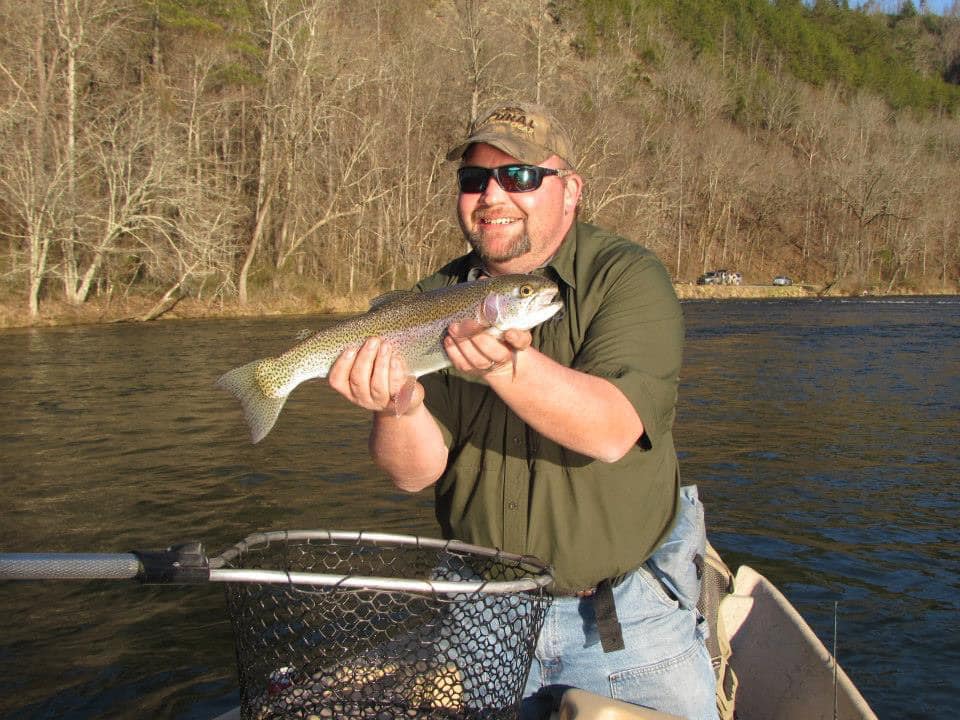
Photo Credit: Lane Kelly
Where to fish
Upper Section (Powerhouse to Reliance)
The upper section is the most popular by far. You’ll find most all aquatic insect hatches through here. This section is most popular for its sulfur and Isochonyia hatch in late spring and early summer. Roadside access is pretty open along the way, except for a couple of spots. There is also the John Muir Trail that parallels the river as well.
Middle (Reliance to HWY 411)
The middle section is generally best fished from spring through early summer. Wading is really accessible here, but you’ll have to be careful if they are generating water or not. It can be floated during generation, but wading becomes more difficult.
Lower (HWY 411 to Patty Bridge)
This section is generally best from late winter to late spring. The caddis hatch during this time is pretty hot and we’ve seen some big fish pulled out of here as a result.
Best Flies to Use
The Hiwasssee is like most fisheries in Tennessee and experiences several hatches throughout the year. Starting in early spring with mayflies and caddis followed by bwo’s and sulfurs in late spring. Throughout the summer, you can expect to see a prolific hatch of Isochonyias that will last through the fall. All in all, the Hiwassee is a great river for the dry fly fanatic. Toward the end of fall you’ll see the October Caddis hatch and it’s quite a site. Early winter, white mini dungeons are our streamers of choice and stoneflies and midges all fish well throughout the winter.
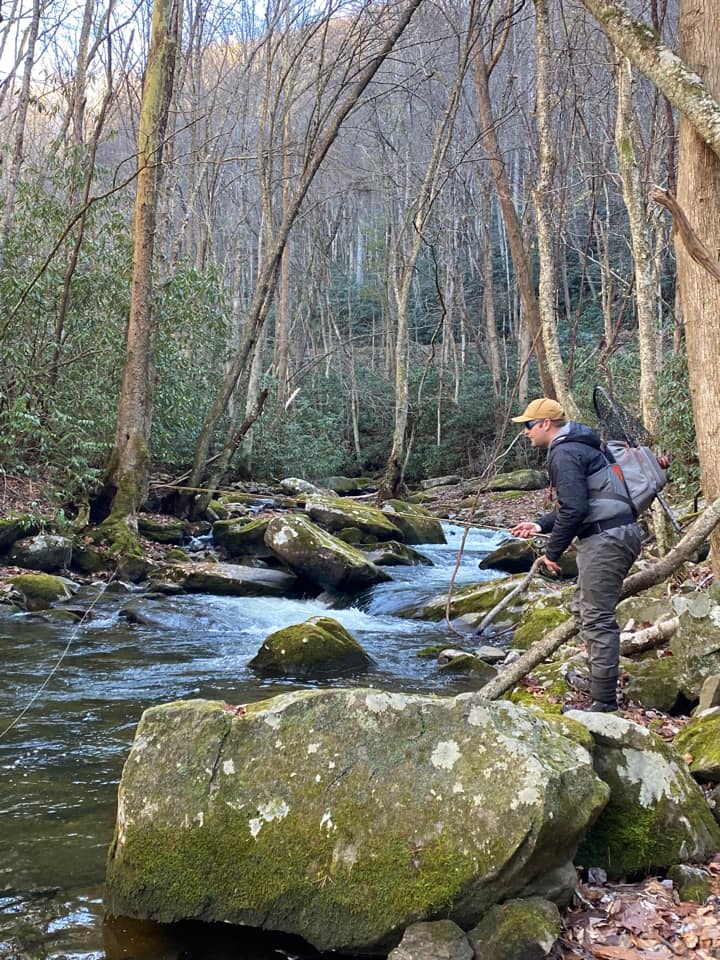
4. Tennessee Fly Fishing:
Abrams Creek (GSMNP)
Another GSMNP gem is Abrams Creek. Situated at the halfway point, between the Tellico River and Gatlinburg, lies this true, blue ribbon stream. With the largest population of wild trout in the park (5,000 per mile) it’s not one to miss! If you’re looking for a beautiful destination with great fishing, this is it! Many anglers would even go as far as saying it’s one of the best trout streams in the entire park! It has an abundance of insect life and the fishing here and plenty of access points from Cades Cove or through various campgrounds along the way. Although most fisherman here are day trippers, there is an opportunity to extend your chances of success and make a weekend out of it as well.
Photo Credit: Rylyn Small
Where to fish
Lower Section
This section is found near the intersection of Abrams Falls trail, Hannah Mountain trail and Hatcher Mountain Trail. Hiking in is the only way to access it. With access both from the North Side (Cades Cove) and the Southern Side (Abrams Creek Campground), it makes the most sense to drive to the campground and hike up. Most of the stream below the campground is unwadable because of the depth of the water here. You’ll find from the campground to the intersection of the trails mentioned above characterized by much slower moving water and deeper pools. Still a great place for trout to hide!
Middle Section
Just above Abrams Falls, from the 2nd horseshoe like curve in the stream, to 2 miles below Abrams falls makes up this section. This section receives much less pressure because the trail gets a bit more demanding after Abrams Falls. For about 2 miles after the falls, you’ll find a pretty amazing section of river to fish. Most of this is accessible trailside, with a few spots that may require some off trail exploration in order to reach the creek. It should be noted that the further downstream you go, the more the creek loses its mountain stream characteristics and starts to open up more.
Headwaters
You’ll find the headwaters, or at least the section of it that appears above ground, near Cades Cove. This section contains what some anglers call the best section of Abrams Creek, The Horseshoe. With most of this section trailside to Abrams Falls Trail, the stream leaves the trail and follows a circular like pattern and ultimately returns back to the trail where it left. There is about 1.3 miles of stream in this section that don’t receive a lot of pressure and house some pretty spectacular fish. From Cades Cove to right above Abrams Falls makes up this section and it’s creek like characteristics begin to diminish the more you go downstream. With the exception of the Horseshoe, most of the upper reaches receive more pressure due to the easy access.
Best Flies to use
During springtime, successful catches can be made using Quill Gordons and Large Green Drakes. In summer, Blue Winged Olives and Little Yellow Stonefly hatches are prominent. Fall is a great time to fish with BWOs and Brown Sculpins. Even during winter, the creek’s underground flow keeps the water temperature moderated, allowing for good fishing year round. Blue Winged Olives start hatching in February, and Blue Quill mayflies and Little Black Caddis appearing in March and make for some great options on dry fly fishing coming out of the winter months.
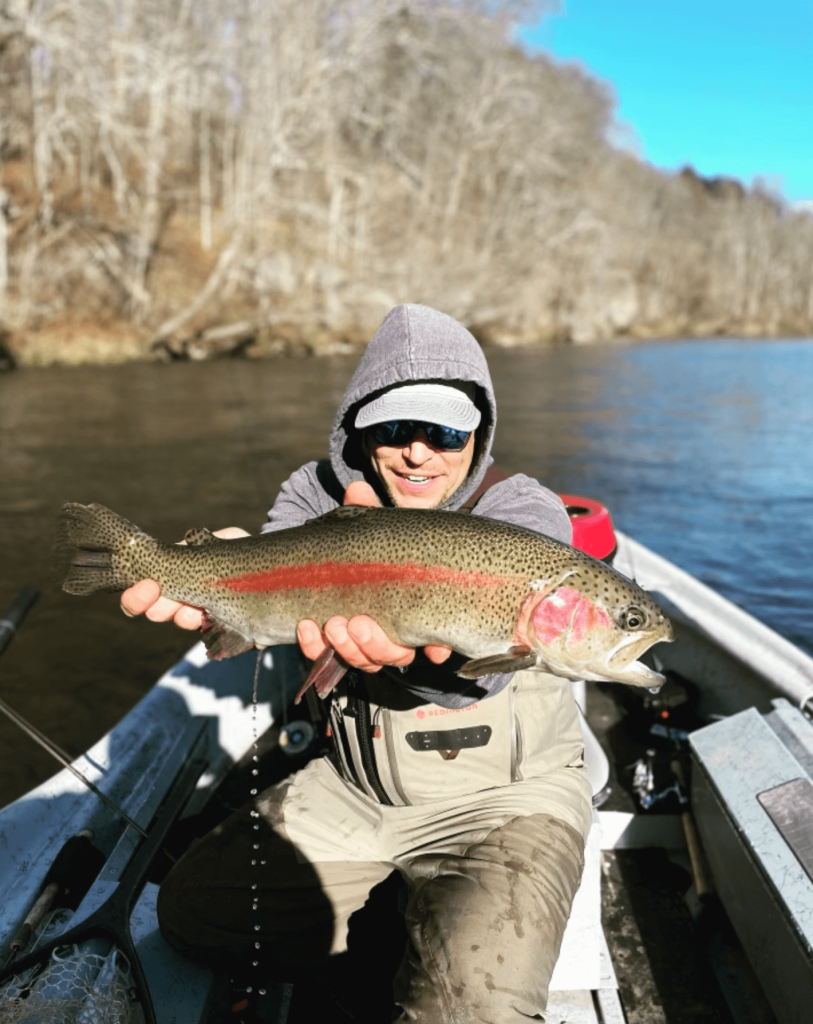
5. Tennessee Fly Fishing: Watauga River
The Watauga River is another great tailwater fishery in East Tennessee. Located in Elizabethton, just outside of Johnson City, the Watauga starts at WIlbur dam and flows to Boone Lake. It’s preceded by 2 reservoirs, Wilbur and Watauga Lake, that prove to keep the Watauga’s water cold and productive year round. With it being a short 25 minute drive from Bristol, Virginia, this blue ribbon fishery is a must fish when visiting this region. It holds some truly spectacular fish and what you don’t catch in numbers, you’re sure to make up for in size. It has 2 primary tributaries in the Doe and Little Stony Creek, both of which are excellent fisheries in themselves. You’ll find rainbows and browns to average around 10-12″, with the trophy section boasting the areas best shot at some truly large fish.
Where to fish
Trophy Section
This section can only be fished when the river is generating. The put in is at Blevins Boat ramp, but the true trophy section doesn’t start until you get to the bridge at Smalling Rd. There are tons of runouts and pools through here and are best fished dead drifting streamers near the eddy lines. We’ve caught some monster rainbows out of here, but browns are present too. If you’re nymphing, be sure to adjust your line length for proper depth frequently as it does change throughout here as well. In addition to it being great for fishing, it’s just a beautiful area to enjoy the scenery as well.
Siam Bridge
With good roadside access, the Siam Bridge offers a great section for wade fishermen. Although this river is best fished from a drift boat, you’ll find a few good spots to wade in along the way. We generally park right before the bridge and walk down to the right to get in the river. There is an old bridge foundation that trout like to hang around. There is a ton of grass beds throughout this section as well, giving the trout the perfect place to hide and chase after some food.
Moose Lodge
Another great spot to wade fish is the Moose Lodge. Situated right next to the confluence of the Doe River, there is a large parking lot anglers can use. Walk across the grass lot to the river and you have a good chance for good fish. Do try to park toward the back of the lot, especially if they have a function going. Although the land is private property, they are pretty generous to fishermen. Normally during the day, you should be fine parking here. The best spots for fishing are upstream of the confluence. There are several ledges and runs through here which have produced good fish for us in the past.
Best Flies to use
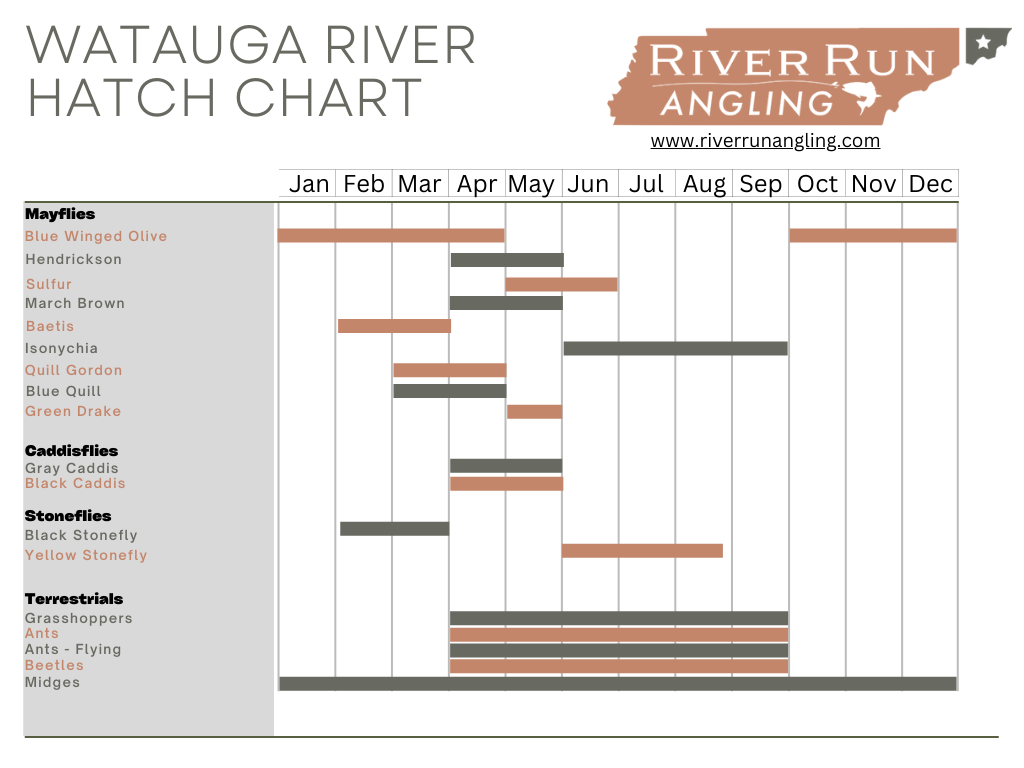
6. Tennessee Fly Fishing:
Doe River Headwaters
Located in the far Northeast corner of Tennessee amid the Cherokee National Forest is the Doe River. This is another truly wonderful mountain stream fly fishing experience. Located at the base of Roan Mountain, this part of the Doe is a wild and wonderful experience. Running from here it twists and turns down the mountain where it will ultimately join the Watauga River. There are 2 primary sections to fish here because a lot of the river runs through private property. Don’t let that deter you though. The public access portions are definitely worth the trip. You’ll find native brooks, browns and rainbows here, with a healthy population of stockers as well.
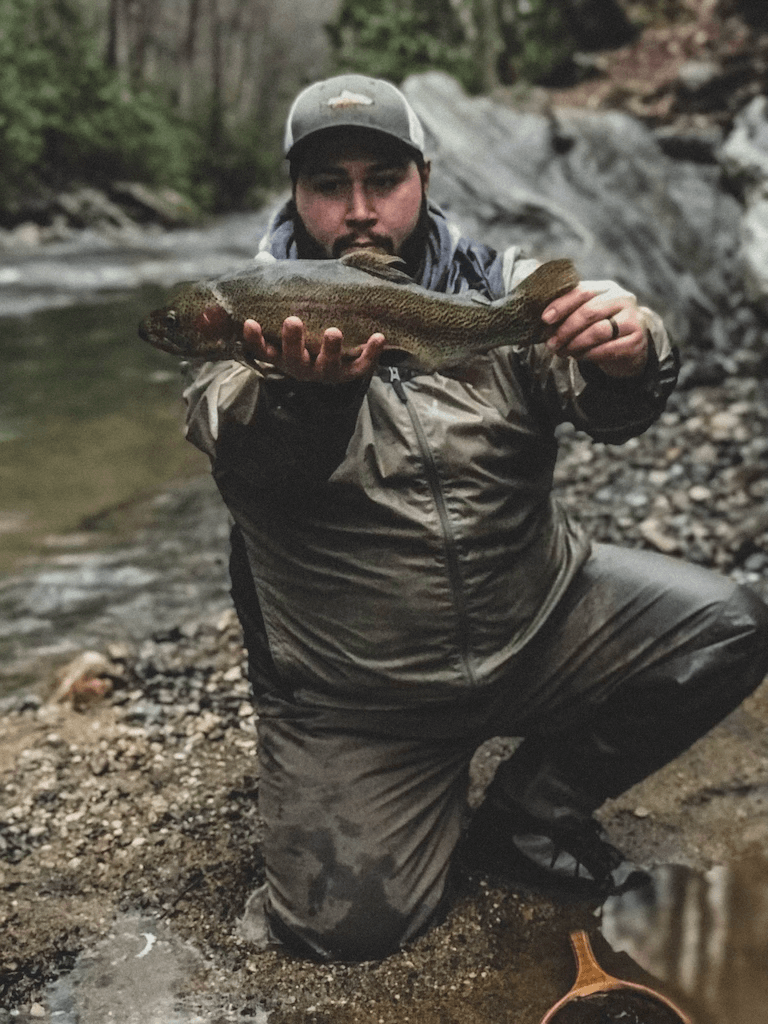
Photo Credit: Stephen West
Where to Fish
Roan Mountain State Park
As you enter the park, you’ll find the road parallels the stream. A lof these sections have pullofs that you can access the river from. There is also a lot of private property here as well. The national forest starts about 100 yards downstream of the visitors center. You can fish anywhere through here up to where the campground is. We generally start out at the campground and hike up the trail that parallels the creek. You’ll find various sizes of fish here, but they average around 6-10 inches. As you can see, there are some big trout here as well.
Doe River Fishing Trail (DRiFT)
The Overmountain Chapter of Trout Unlimited established this trail in 2018. It has public access points in 6 different areas that span around 8 miles. There are also several single car pull-ins along Old Railroad Gauge road that provides access as well. This section primarily has stocked trout, but there are some wild trout to be found here too. The advantage of this section is that everything is accessible near the road way. This is also a disadvantage as well, because you may have some traffic noise to deal with. The portion that runs through town is mostly private property. Most of the trail is highly marked though to leave out room for confusion.
Best Flies to Use
As always, the best way to choose your flies will heavily depend on what’s hatching at the time. Most of the year, especially in the warmer months, the deadliest combination we’ve found is a dry dropper combo. Throw a stimulator or elk hair caddis on top and drop a small nymph or midge pattern to match the depth you’re fishing. You can’t go wrong with this combo. In the winter months, the fishing does slow down tremendously. Fish aren’t hitting the combo we mentioned before, but it doesn’t mean you can’t catch one. It just drops off a lot.
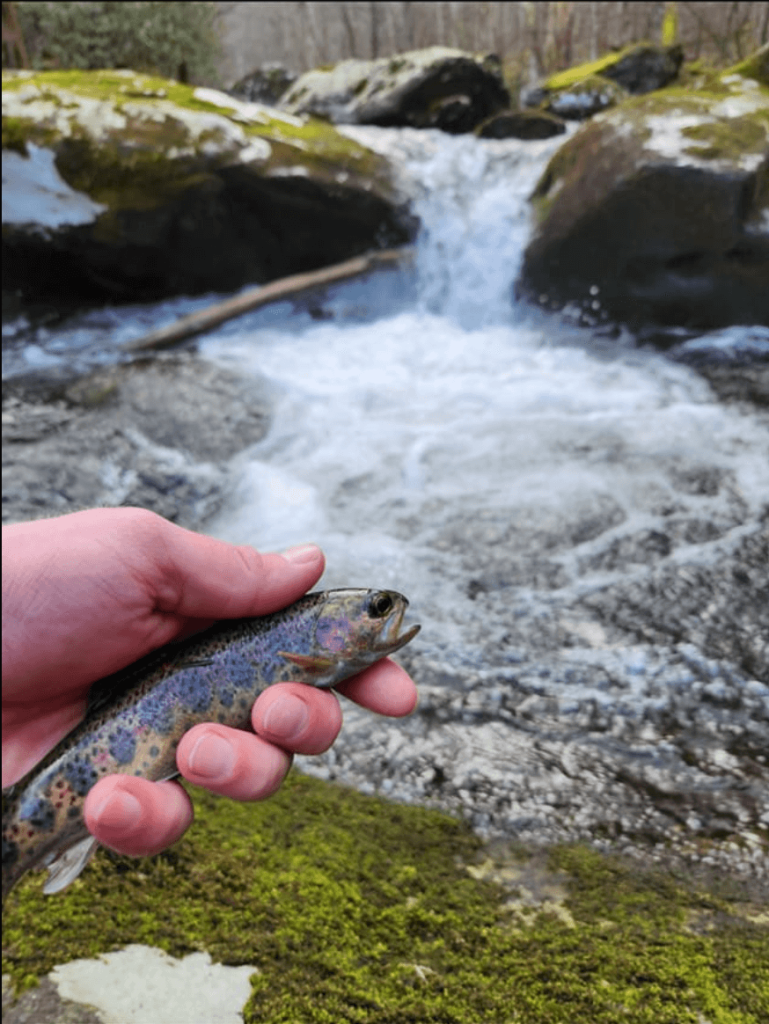
7. Tennessee Fly Fishing: Citico Creek
About 13 miles due East of Tellico Plains, TN (at least as the crow flies) lies Citico Creek. It’s tucked away in the Cherokee National Forest in Monroe County, Tn! You’ll find wild and stocked rainbow, with wild brown trout here and the native brook trout as well. Towards the lower stretches, where it runs into the Little Tennessee River, you’ll run into other types of fish like catfish and smallmouth bass. It’s headwaters lie in the Citico Creek Wilderness area near Brush Mountain. The north fork and south fork are your best bet for going after some wild trout. You should take note that there some regulations you need to adhere by during certain times of the year. You can find more out about that here.
Photo Credit: Brad Ervin
Where to Fish
Double Camp Recreation Area
This is a wonderful area if you’re looking to get away from the crowds. There are several campsites back here and the fishing is pretty good too. Even during the busier months, this area doesn’t see as much action as a lot of other primitive campgrounds. During the warmer months you can wet wade here, but I would definitely want waders starting around September and October.
Citico Creek Road
This road parallels the stream up until the confluence of the North Fork and South Fork. There are several places to park a long the way and enjoy the fly-fishing there. Some days, you can be content to stand in one section all day long because the scenery is just that good.
Best Flies to Use
Just like the other mountain streams, these fish generally will eat most anything. We’ve found that during the warmer months they are really attracted to dries like an Elk Hair Caddis or Stimulator. A Blue Wing Olive is also a pretty safe throughout the year as well. In the winter time, it get’s a lot more challenging to catch these fish. Nymphing or streamer fishing in the winter is your best bet. Since they’re so lazy and holed up in the deeper pools, unless you run a wooly bugger into one and get your nymph to float right over their nose, they’re not moving much.
Summary
To wrap things up, there is a ton of great Tennessee fly fishing to be found in our great state! It really could take a lifetime to narrow it down to the top 7. Every angler is different and enjoys different types of fishing. That’s what makes this sport so great. That and the fact that our fishing season is year round. That’s pretty awesome too!
A few rivers that didn’t make our top 7, but are some notable shoutouts are: The Elk River, Caney Fork River and Clinch River. Whether you’re a river only type fishermen, or you enjoy catching largemouth bass and walleye on our lakes. You’re certain to find what you’re looking for in the waters of Tennessee. No matter if you’re a conventional fishermen or fly angler, Tennessee has some of the best fly fishing in the nation. Although we’re pretty partial to the Northeast counties in the state, no matter where you choose to fish, or what brand rod and reel you have, just get out there and enjoy it!
